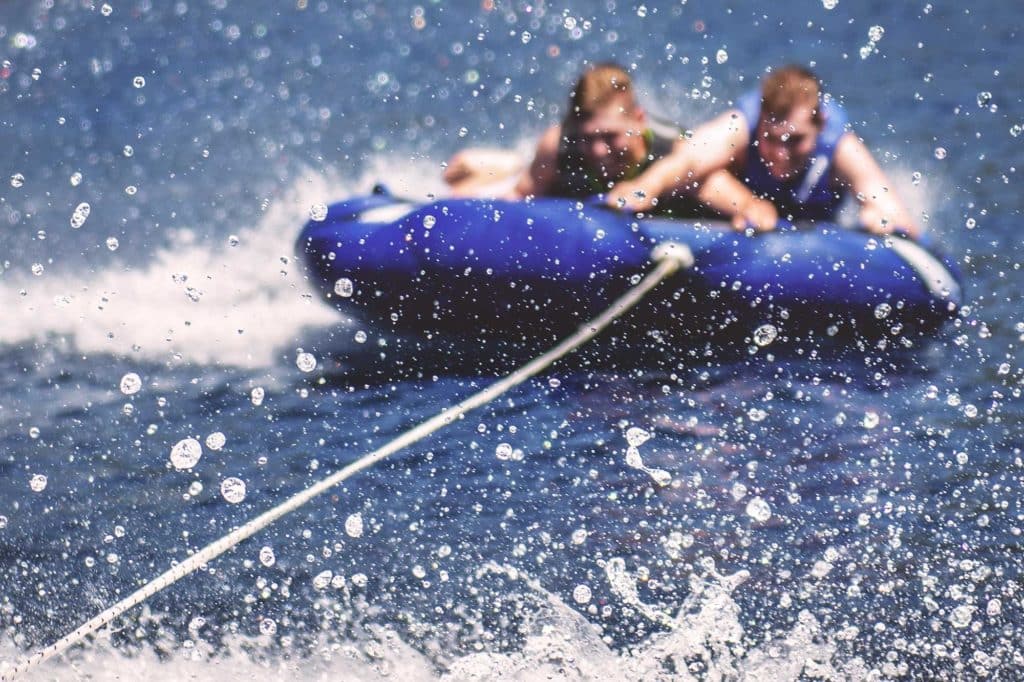
Pulling something is pulling something, right? Whether it’s skis, a wakeboard or towable tube?
And securing a towing rope is securing a towing rope, right? Whether to a wakeboard tower, ski pylon or transom tow eye?
And a rope is a rope is a rope, right?
The answer to all three rhetorical questions is an emphatic “No!”
Tubing is one of the most accessible, inclusive and fun things you can do on the water, but towing a tube generates way more drag than pulling a skier or wakeboarder. Wakeboard towers just aren’t made for that kind of load, nor are tall pylons. In fact, if the tube submarines—gets pulled under, which they sometimes do—a towline connected to a high tower or pylon can actually pull the boat over.
A tube’s drag could also tear the tower or tall pylon from your boat, with plenty of damage and injury possible. Towers are made specifically for wakeboarding and surfing, and most have stern warnings against other uses. For these reasons, tube manufacturers say their creations perform best when tethered from a lower point.
That leaves a shorter transom ski pylon (no higher than 2 feet off the floor), a centered transom tow eye, or a harness tied between port and starboard transom rings as your best bets for tubing. If using transom tie-down eyes, confirm with the boat manufacturer that they’re strong enough for the towing force listed on the tube’s packaging. Many tubes can produce more than 1,000 pounds of drag.
And the rope? Just like towing points, it should be made specifically for towing inflatables. Compared to wakeboard and ski ropes, tubing ropes are much stronger, rated at 2,000-, 4,000- or 6,000-pound breaking strengths and for a specified numbers of riders, and measuring at least 50 but no more than 65 feet long. Check your rope regularly for fraying, fading, knots and other damage—and replace if necessary.
It’s true that a low tow point can make it tricky to keep the towrope above the water. A workaround is a booster ball or bobber, which holds the rope high and visible, and aids tube performance. And isn’t big-fun performance what tubing is all about?
More tube tips:
- Only tow a tube if the boat has a qualified driver and capable observer.
- Tow in control; Getting a little air is fine if your riders are game, but overdoing it, especially on multi-person models, can slam riders’ bodies into each other and cause severe injuries.
- Remember to use hand signals and a red flag to communicate between the boat, tubers and other boaters.
- When the boat is turning at 20 miles per hour, the tube can be going up to 55 miles per hour. That’s called the whip.
- Maintain an appropriate speed for your riders. A good guideline is an 8 mph limit for small kids, 15 mph for older kids, and 20 mph for adults.
- Stay at least two rope lengths away from swimmers, shallow water, other boats and obstacles.
- Make sure the line is always tight before you accelerate.
- Always pick up a fallen tuber on the driver’s side.
- Make sure you attach the engine cut off switch lanyard, and that all tubers and boat passengers are wearing a USCG-approved life jacket.
The U.S. Coast Guard is asking all boat owners and operators to help reduce fatalities, injuries, property damage, and associated healthcare costs related to recreational boating accidents by taking personal responsibility for their own safety and the safety of their passengers. Essential steps include: wearing a life jacket at all times and requiring passengers to do the same; never boating under the influence (BUI); successfully completing a boating safety course; and getting a Vessel Safety Check (VSC) annually from local U.S. Coast Guard Auxiliary, United States Power Squadrons®, or your state boating agency’s Vessel Examiners. The U.S. Coast Guard reminds all boaters to “Boat Responsibly!” For more tips on boating safety, visit www.uscgboating.org.








